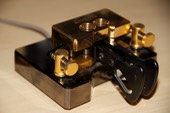My experience to date in learning the code
As you would have already seen and read I have only been active in CW mode since the start of 2005. Prior experience zero, zilch, nothing! My local club does operate a CW practice evening, however this usually coincides with family and work schedules. My learning is all self-taught.
I won't go back into the motivation of wanting to learn code, suffix to say I did. I thought sharing some of my learning experiences maybe useful to others who also want to learn the code - or just be involved in CW mode.
There are some very strong minded people who state different ways to learn the code, how proficient you need to be and that you have to more or less complete a 'CW apprenticeship'. I disagree with a lot that has been written as this train of thought doesnt' take into account new technology that is around. These people mostly learnt the code in the days when they did military service and were 'forced' to learn in a full-time classroom environment over several weeks. Their approach will ensure that CW eventually fades away. I don't begrudge or hold any ill feelings - its just that its not the same today. The less 'old school' had to learn CW as part of gaining their ticket. Now that the CW requirement is no longer part of the licensing procedure I say we should use new technology as a way of getting involved.
I started learning the code by just listening to CW using the Koch program. Within about six weeks of listening about 30 minutes a day, I had a basic understanding of how the code sounds. This was at a 7wpm, but at a 20wpm character rate. I found using the Koch program that I could copy code at about a 90% accuracy. I bought a straight key and started to send practice CW through my FT-897 oscillator. I tried to mimic the sounds I was hearing on the computer. I also listened around the CW portions of the bands. Only on very few occasions could I copy what people were transmitting. This disappointed me as I had spent weeks learning CW only to find that I couldn't copy it for real. Regardless I started calling CQ using the straight key I had bought. No one came back to my calls. The feel of the key didn't feel good and my CW experience started to get worse.
I am not a quitter and decided to try a slightly different approach. I bought an old paddle and started using the FT-897 internal keyer. This meant character stroke, timing and spacing were correct. I also started using a PC Morse decoder program to decode signals received. I still continued / continue to practice with the Koch program.
I started making rudimentary CW contacts. Fantastic! More contacts followed and my sending became less scratchy. more and more contacts followed and my confidence increased in my sending ability. Receiving using a PC Morse decoder program has limitations. If the code is not perfect, the program does not decipher properly and you end up reading gibberish. I found that as my sending improved my ability to copy code in my head also improved. Testing myself with the Koch program I found that I can now copy about 10wpm at a 20wpm character rate. Usually people send their code at around 15-20wpm and using my head along with a PC Morse decoder program helps me fill in the blanks when conditions are not great.
I then bought a Begali paddle and a CMOS-4 keyer. (Self bought birthday presents)
I'm now having fun. That's what this hobby is about. My CW proficiency is on the increase, sending is much better and copying is much better. I hope to, over a period of time, copy most code in my head rather than use a computer. But in saying that, does it really matter? If your sending and receiving CW manually or via a computer at least your involved. My home QTH does not permit fantastic antennas or high power, CW is a mode that allows for low power and limited station set up.
So what have I learnt?
It doesn't matter how you receive and send code. Use a computer or do it manually.
If you want to manually send and receive;
1. Get a basic understanding of the code.
2. Use the Koch program as a learning aid - its very good.
3. Use a paddle and keyer to send code - that way you'll be understood.
4. Use a Morse decoder program to start with - at least you'll make QSO's.
5. Just give it a go. By giving it a go your learning will start and over time you gain proficiency.
